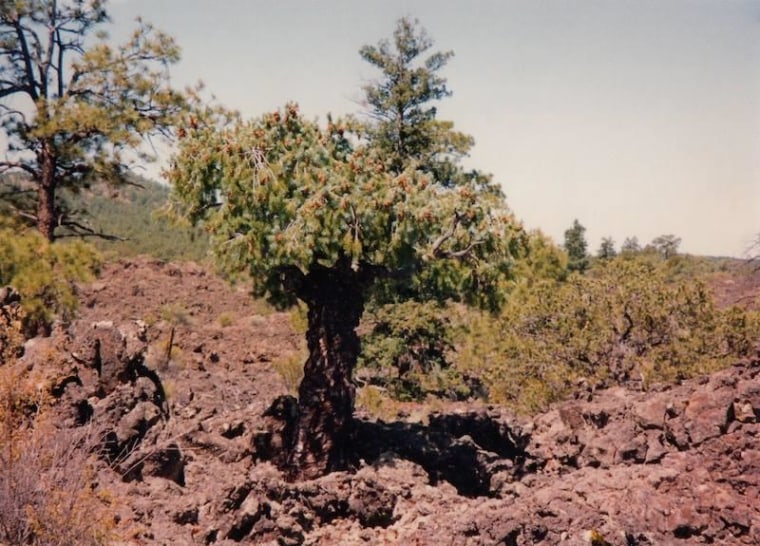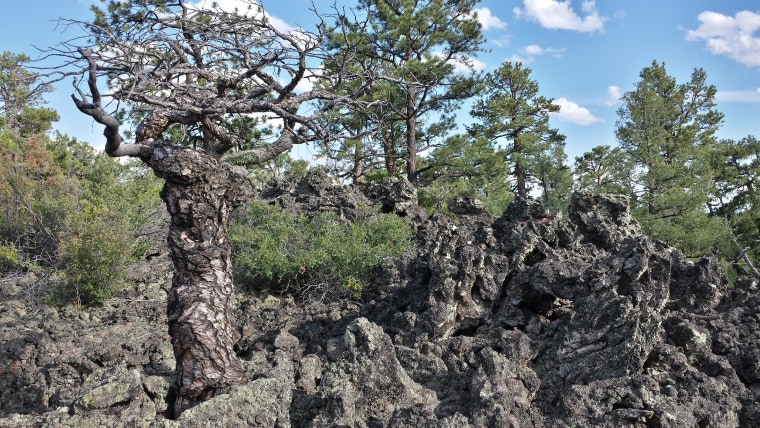A Douglas fir affectionately named Yoda survived many a drought in its six-plus centuries of existence in a rugged lava flow in the El Malpais National Monument area near Grants, New Mexico, but it couldn’t weather the current extreme drought in the parched Southwest.
The recent death of the 7-foot-tall tree, estimated to be more than 650 years old, is a testament to the severity of today's drought, scientists say.
A core sample obtained in 1991 established that Yoda had lived at least since 1406, but it likely had been alive since 1350 or so, Henri Grissino-Mayer of the University of Tennessee, Knoxville, told NBC News. Yoda had survived a “megadrought” in the 16th century — an intense period of dry weather that plagued Mexico and North America for decades and caused major tree losses.
Today, Grissino-Mayer said, “We’re seeing massive mortality in tree populations that is unprecedented.”
So why did Yoda survive the wicked, prolonged drought of the 16th century but not the current one? The reason might be a warmer climate now.
“During the 1500s, the Northern hemisphere was in the period known as the Little Ice Age. So when there was a drought, the effects were less because it was cooler,” said Grissino-Mayer, a professor in the university's Department of Geography who studies the science of tree rings.
Now the temperature has risen, about 1.5 degrees centigrade (2.5 degrees Fahrenheit), he said. The combination of drought and higher temperatures was too much for Yoda.
“We are in unprecedented temperatures — temperatures that are unlike anything that these trees have gone through,” he said.
“I have a feeling that when this drought is over we’ll be able to say this was equal to or worse than the drought of the 16th century.”

Signs of aging
Grissino-Mayer took his first trip to El Malpais National Monument in 1990 and first saw Yoda in May 1991.
Back then, the tree was healthy.
“If you look at the 1993 photo, it has Douglas fir cones all over it. That tree was 650 years old and still reproducing.”

But by 2010, Yoda was already feeling the effects of the drought. The crown had thinned out, like an aging man’s balding head.
Grant Harley, an assistant professor of geography at the University of Southern Mississippi, said the tree was alive when he and his wife visited it in March. But when he returned to the site in August with some graduate students, all its needles were gone — a telltale sign that Yoda was dead.
"The fact that this tree, 650 years old, survived the megadrought, lived through that but could not survive the recent drought, is pretty telling."
"It is sort of disturbing, I guess. We walked up to him and expect him to be alive, and we find him dead," Harley said.
"The fact that this tree, 650 years old, survived the megadrought, lived through that but could not survive the recent drought, is pretty telling."
While old, Yoda is hardly the most senior of trees in New Mexico’s El Malpais National Monument area.
“The tree right next to Yoda, about 25 feet away, goes back to the year 1062,” Grissino-Mayer noted.
The oldest Douglas fir in the Malpais for which he had records would date to 1,297 years ago, if it’s still alive, he said.